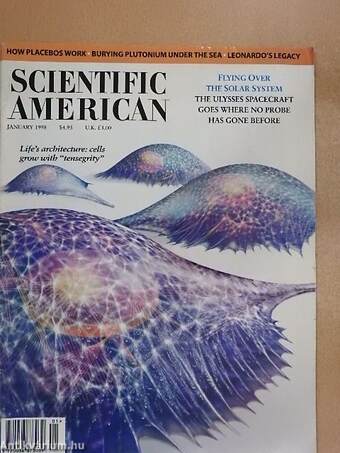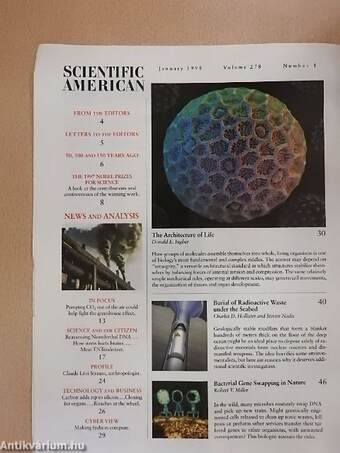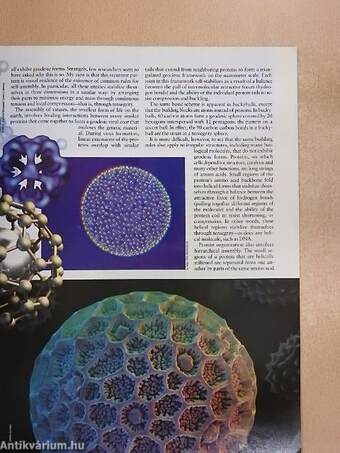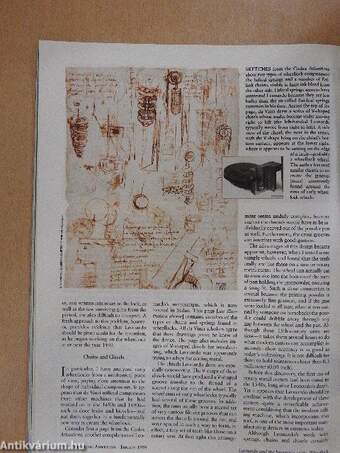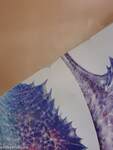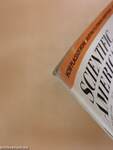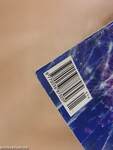1.067.715
kiadvánnyal nyújtjuk Magyarország legnagyobb antikvár könyv-kínálatát

VISSZA
A TETEJÉRE
JAVASLATOKÉszre-
vételek
Scientific American January 1998
Volume 278 Number 1
| Kiadó: | Scientific American, Inc. |
|---|---|
| Kiadás helye: | New York |
| Kiadás éve: | |
| Kötés típusa: | Tűzött kötés |
| Oldalszám: | 92 oldal |
| Sorozatcím: | Scientific American |
| Kötetszám: | |
| Nyelv: | Angol |
| Méret: | 27 cm x 21 cm |
| ISBN: | |
| Megjegyzés: | Színes és fekete-fehér fotókkal, illusztrációkkal. További kapcsolódó személyek a műben. |
naponta értesítjük a beérkező friss
kiadványokról
naponta értesítjük a beérkező friss
kiadványokról
Tartalom
SCIENTIFIC AMERICAN
FROM THE EDITORS
4
LETTERS TO THE EDITORS
5
so, 100 AND 150 YEARS AGO
6
THE 1997 NOBEL PRIZES FOR SCIENCE A look at the contributions and controversies of the winning work.
NEWS AND ANALYSIS
January 1998
Volume 278
Number 1
IN FOCUS Pumping CO2 out of the air could help fight the greenhouse effect.
13
SCIENCE AND THE CITIZEN
Reassessing Neanderthal DNA
How stress hurts brains____
Meat TNTenderizer. 17
PROFILE
Claude Lévi-Strauss, anthropologist.
24
TECHNOLOGY AND BUSINESS
Carbon adds zip to silicon____Cloning
for organs____Roaches at the wheel.
26
CYBER VIEW Making fashion compute.
29
The Architecture of Life
Donald E. Ingher
How groups of molecules assemble themselves into whole, living organisms is one of biology's most fundamental and complex riddles. The answer may depend on "tensegrity," a versatile architectural standard in which structures stabilize themselves by balancing forces of internal tension and compression. The same relatively simple mechanical rules, operating at different scales, may govern cell movements, the organization of tissues and organ development.
Burial of Radioactive Waste under the Seabed
Charles D. Hollister and Steven Nadts
40
Geologically stable mudflats that form a blanket hundreds of meters thick on the floor of the deep ocean might be an ideal place to dispose safely of radioactive materials from nuclear reactors and dismantled weapons. The idea horrifies some environmentalists, but here are reasons why it deserves additional scientific investigation.
Bacterial Gene Swapping in Nature Robert V Miller
46
In the wild, many microbes routinely swap DNA and pick up new traits. Might genetically engineered cells released to clean up toxic wastes, kill pests or perform other services transfer their tailored genes to other organisms, with unwanted consequences? This biologist assesses the risks.
52 The Ulysses Mission
Edward}. Smith and Richard G. Marsden
Of the dozens of spacecraft sent to explore the solar system, only Ulysses has veered far from the ecliptic, the thin disk containing the planets. Now looping over the sun's poles in an orbit as wide as Jupiter's, Ulysses has a unique view of the wind that is advancing stellar astrophysicsr'
5 8 Lise Meimer and the Discovery of Nuclear Fission
Ruth Lewin Sime
As one of the discoverers of nuclear fission, physicist Lise Meitner should have shared in the 1944 Nobel Prize with her chemist colleague Otto Hahn. But wartime political oppression and anti-Semitism obscured her full contributions.
64 Picosecond Ultrasonics
Humphrey Maris
An instantaneous flash of laser light can set up ultrasonic vibrations lasting just trillionths of a second. Industrial engineers are now learning how to put these all but imperceptible sound waves to work in sonar systems that can probe thin semiconductor films or other materials for flaws.
68 The Placebo Effect
Walter A. Brown
Doctors and patients ascribe healing powers to many treatments that have no direct physiological influence on a malady. This placebo effect, in which the very act of undergoing treatment aids recovery, has generally been disparaged by medicin« but more effort could be made to harness it.
74 Leonardo and the Invention of the Wheellock
Vernard Foley
Although Leonardo da Vinci sketched many inventions in his notebooks, almost none went into production during his lifetime. At least one may have, however: the wheellock, a device that supplied a spark to gunpowder in firearms.
Scientific American (ISSN 0036-8733), published monthly by Scientific American, Inc., 415 Madison Avenue, New York, N.Y. 10017-1111. Copyright ® 1997 by Scientific American, Inc. All rights reserved. No part of this issue may be reproduced by any mechanical, photographic or electronic process, or in the form ofa phonographic recording, nor may it be stored in a retrieval system, transmitted or otherwise copied for public or private use without written permission of the publisher. Periodicals postage paid at New York, N.Y, and at additional mailing offices, Canada Post International Publications Mail (Canadian Distribution) Sales Agreement No. 242764. Canadian BN No. 127387652RT; QST No. Q1015332537. Subscription rates; one year S34.97 (outside U.S. $47). Institutional price: one year $39.95 (outside U.S. S50.95). Postmaster: Send address changes to Scientific American, Box 3187, Harlan, Iowa 51537. Reprints available: vflite Reprint Department, Scientific American, lnc„415 Madison Avenue, New YorK N.Y 10017-1111;fex: (212) 355-0408. Subscription inquiries: U.S. and Canada (800) 333-1199; other (515) 247-7631; e-mail to info@sciam.com
THE AMATEUR SCIENTIST From kitchen appliance to centrifuge.
80
MATHEMATICAL RECREATIONS
Bubbles make complex math easy.
82
REVIEWS
AND
COMMENTARIES
iiiialSÉMi^^
(!«Slisiiiíá^r
Space history .The Russian who raced the U.S. to the moon.
Wonders, by the Morrisons
The living flame. Connections, by James Burke
Signals from beyond and dispatches from balloons.
86
WORKING KNOWLEDGE Holograms: giving pictures depth.
92
About the Cover
Geometric scaffolding inside cells seems to obey architectural principles identified by the engineer Buckminster Fuller, dynamically redistributing the structural stress. Painting by Slim Films.
Visit the Scientific American Web site
(http://www.sciam.com) for more informa-
tion on articles and other on-line features.
Témakörök
- Idegennyelv > Idegennyelvű könyvek > Angol > Műszaki
- Idegennyelv > Idegennyelvű könyvek > Angol > Természettudományok > Egyéb
- Idegennyelv > Idegennyelvű könyvek > Angol > Folyóiratok, újságok
- Folyóiratok, újságok > Műszaki
- Műszaki > Technika > Egyéb
- Természettudomány > Általános természettudomány > Folyóiratok > Egyéb
- Természettudomány > Általános természettudomány > Idegennyelvű > Angol
- Folyóiratok, újságok > Természettudományok > Általános természettudomány
- Műszaki > Idegennyelv > Angol
- Műszaki > Folyóiratok, közlemények > Egyéb
- Műszaki > Folyóiratok, közlemények > Idegennyelv



